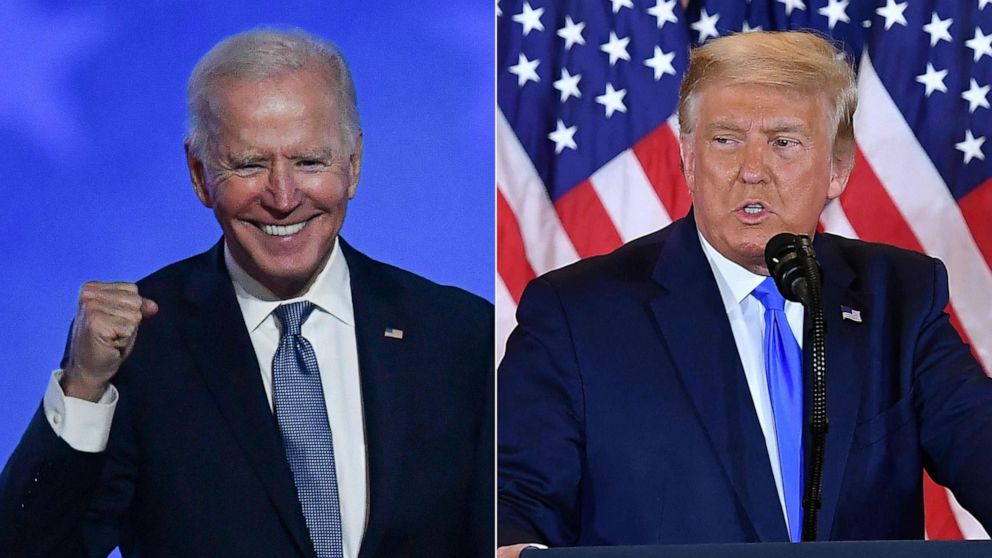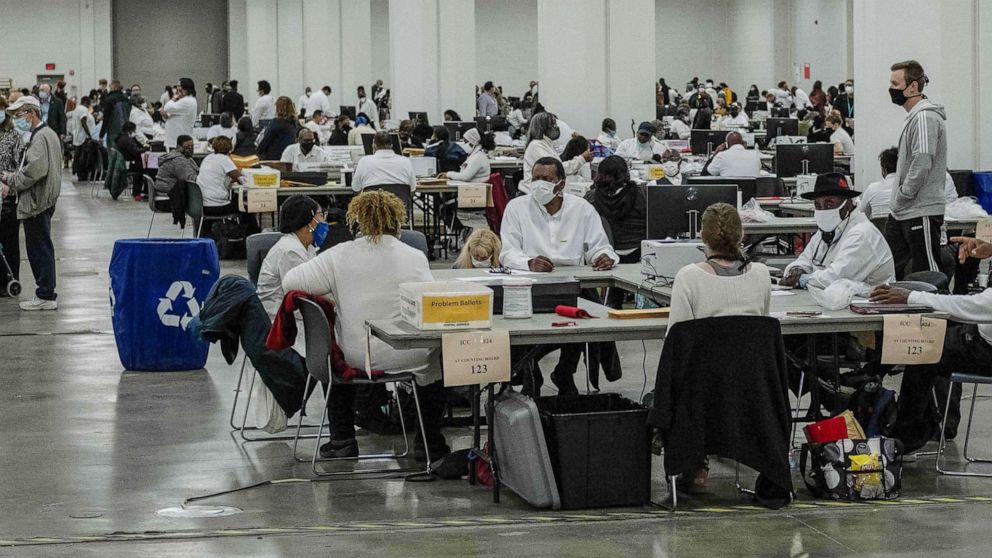这选举这改变了美国人的投票方式,也改变了他们的一些选票的计算速度,使得这个国家悬而未决,即使是作为前副总统乔·拜登改善了希拉里·克林顿在一系列投票团体中的全国表现。
前所未有的64%的选民提前投票,包括34%的邮件投票——这些选票仍在几个关键州进行统计。包括宾夕法尼亚州、密歇根州、威斯康星州、佐治亚州和北卡罗来纳州在内的各州在凌晨时分都没有预测到获胜者。
尽管如此,全国出口民调还是支持了一些宽泛的结论。一个是少数民族在选民中的比例仍在增长——从2016年的30%和1976年第一次投票后的10%上升到35%。多样性列车继续前行。
唐纳德·特朗普改进了一些仪表。不到一半的选民(44%)表示,他有能力胜任总统职务——但这一比例高于四年前的35%。尽管53%的人对他不满意,但这一比例低于2016年的59%。
与此同时,出口民调发现,拜登赢得无党派人士,往往在全国选举中摇摆选民,由14个百分点,54-40%;特朗普在2016年以6分的优势赢得了他们。拜登在出口民调结果中以31个百分点赢得温和派,64-33%;希拉里·克林顿以13分的优势赢得了他们。

法新社通过盖蒂图像
拜登以34个百分点赢得了第一次投票,而克林顿为20个百分点。曾在军队服役的选民支持特朗普7个百分点,低于他2016年在该群体中的24个百分点。尽管差异较小,但拜登在郊区的得分为+3分,而四年前特朗普的得分为+4分。性别差距大幅缩小,但主要是因为特朗普以1个百分点的优势赢得了男性,而四年前是11个百分点。
特朗普的支持率为47-51%,赞成-不赞成,处于水下,但略有下降。仅有的两位在第二次选举中获得负面支持率的总统都输了——吉米·卡特和乔治·布什——但两人的支持率都远低于特朗普。
特朗普和拜登在谁更有能力处理经济问题上基本上陷入僵局,而拜登以51%对43%的优势领先,因为他更能处理冠状病毒大流行。投票者以大约51-42%的票数支持拜登,认为阻止病毒传播是当务之急,而不是特朗普认为重建经济是当务之急。
尽管55%的人说这场流行病给他们带来了经济困难;那些这样说的人以30个百分点支持拜登。
公众对美国对这一流行病的反应是好是坏意见不一,各州之间存在很大差异。与此同时,两倍多的人说情况非常糟糕,34%,同样非常好,17%。
特朗普的差距要大得多,67%至30%的选民认为戴口罩是公共健康责任,而不是个人选择,两组选民的投票差异很大。
最后,两个结果令人振奋,也许超越了党派界限。93%的人说他们的州让投票变得有些或非常容易。87%的人对他们的投票会被公平计算多少有些信心或非常有信心。最终。
接下来是一些关键战场的州际投票结果。亚利桑那州、密歇根州和宾夕法尼亚州的出口民调结果仍是初步的,有待数据调整。
亚利桑那州
自2000年以来,受过大学教育的白人在亚利桑那州总统选举后的民调中支持共和党(早在这个问题被提出之前);今年,他们以55-44%的支持率支持拜登。特朗普反过来赢得了非大学白人。
无党派人士比共和党人多8个百分点,民主党人多14个百分点。越来越多的独立选民(24年前仅占选民的18%)改变了该州作为共和党大本营的声誉,尽管自1952年以来,该州只有在1996年一次投票给民主党总统候选人。拜登在无党派人士中领先,52-39%。
马里科帕县占亚利桑那州选民的十分之六;拜登在那里仅以49-46%的优势领先3个百分点。特朗普在该州郊区选民中总体领先5个百分点。
西班牙裔选民占亚利桑那州选民的19%,而2016年和2012年分别为15%和18%。他们以30个百分点的优势支持拜登,类似于他在全国西班牙裔选民中以34个百分点的优势获胜。
佛罗里达
在佛罗里达州的出口民调结果中,共和党人比民主党人多7个百分点,分别为37%和30%,这是1988年佛罗里达出口民调数据中最大的研发差距,与2016年的33-32%相比有所变化。此外,特朗普获胜的关键是郊区居民领先9个百分点,为54-45%,类似于他2016年在佛罗里达郊区的+10。
65岁及以上的成年人占佛罗里达州选民的31%,创下新高,比2016年的26%有所增加。特朗普以52比47%的优势赢得了他们,但与2016年相比,差距更小,为17个百分点。
非古巴裔西班牙人以56比43支持拜登,比2016年克林顿-特朗普的71比26票数还要多。古巴裔美国人以56-41%的投票率支持特朗普-拜登,与四年前类似。
拜登以59-39%的优势赢得了温和派的支持,但在一个保守派人数超过自由派38%至20%的州,这还不够。
从地区来看,北部/狭长地带的选民以50-49%的票数击败了特朗普;这个群体在2016年支持特朗普20个百分点。特朗普在迈阿密/黄金海岸地区以更接近的优势获胜,仅领先拜登13个百分点,而克林顿的领先优势为+27个百分点。
格鲁吉亚
自1992年以来,格鲁吉亚没有出现过民主党总统候选人。希拉里·克林顿在2016年获得州冠军时差5分;出口民调结果显示,拜登在这方面有所改善,尽管选票尚未统计。
18岁至29岁的选民占选民总数的21%,高于2016年的15%;他们以55%对42%支持拜登。受过大学教育的白人从2016年特朗普-克林顿的69-28%上升到56-42%。而在占全州选民28%的亚特兰大郊区,是拜登+10,而2016年是特朗普+6。
和其他地方一样,这种流行病的威胁很大。半数选民表示,遏制冠状病毒比重建经济更重要;他们以82-17%的多数支持拜登。相比之下,45%的人说重建经济更重要,对他们来说,结果正好相反:82%的人支持特朗普,17%的人支持拜登。
密歇根
特朗普在2016年的480万张选票中以10,704票赢得密歇根州,这是该年任何一个州的微弱优势,也是自1988年以来共和党总统候选人第一次在该州获胜。他受到独立选民16个百分点的支持率、郊区居民11个百分点的支持率以及奥巴马2012年在工会家庭中20个百分点的支持率的推动。最新的出口民调结果显示,拜登以51-43%的优势赢得了独立选民;郊区的特朗普+2,48-50%,工会家庭的拜登-特朗普结果为56-41。

赛斯先驱报/法新社通过盖蒂图像
拜登在这些群体中的进步被其他转变所抵消。2016年,民主党人的人数比共和党人多9个百分点,但这些群体的比例在周二相当均匀,37%的共和党人和36%的民主党人。工会家庭的选民占密歇根州选民的22%,而2016年为28%。18至29岁的人,一个强大的拜登团体,占选民的13%,而四年前为18%。
美国北卡罗来纳州
特朗普希望重现他在北卡罗来纳的微弱胜利,四年前他以4个百分点的优势击败了希拉里·克林顿。种族和少数民族投票率的提高没有帮助;在出口民调结果中,他们占北卡罗来纳州选民的36%,高于2016年的30%,与拜登的支持率相差无几,为79-17%。
拜登还得益于受过大学教育的白人的蓝调,他们从四年前特朗普的+19个百分点上升到特朗普-拜登50-48%的分裂,这是自1988年以来共和党在该群体中的最微弱优势。
特朗普巩固了他在核心群体中的支持。保守派占选民的39%,支持特朗普的支持率从2016年的68%上升到79%。特朗普还扩大了他在非大学白人中的优势,从44分战胜克林顿,到56分战胜拜登。
宾夕法尼亚州
宾夕法尼亚州十分之四的选民提前投票,该州法律禁止在选举日之前计票,该州的计票工作周二没有完成。特朗普在2016年以不到一个百分点的优势赢得了该州的选票。
根据出口民调,郊区的投票率接近50-48%,特朗普-拜登,女性倾向于拜登,男性倾向于特朗普。特朗普保持了他在2016年在非大学白人男性中的广泛胜利,目前为72-27%,但将拥有学位的人分成49%和拜登的49%。
54%的选民优先考虑遏制冠状病毒,43%的选民优先考虑重建经济,54%的选民认为拜登能比特朗普更好地应对这一流行病。但经济仍然很重要:47%的人说他们经历了与新冠肺炎相关的金融困难,38%的人选择经济作为他们投票中最重要的问题(五个选项中的多数选择)。在全国范围内,特朗普和拜登在谁能更好地处理经济方面存在分歧,分别为50%和48%。
威斯康星州
随着大流行的肆虐和全国第三高的人均病例数,53%的威斯康星州选民表示,美国遏制大流行的努力进展不佳。维斯康尼特斯以52%对44%的优势表示,拜登在应对疫情方面会比特朗普做得更好。特朗普和拜登对候选人处理经济的评价更接近,分别为49%和48%。
与2016年一样,特朗普赢得了非大学白人男性——但他在更新数据中的27分、62-35%的结果低于四年前的43分。受过大学教育的白人男性中,拜登和特朗普的差距为51比48,与2016年的差距相似。
特朗普-拜登在郊区的支持率为55-43%,郊区女性的支持率甚至接近50-49%。四年前,特朗普在支持率上落后29个百分点,但赢得了该州(不到23000票)。今年,他的支持率略有提高——43-56%,有利-不利。拜登的情况是51-48%,比2016年克林顿的42-56%要好。
加里·兰格、克里斯蒂娜·费勒、索菲·西诺齐奇、艾莉森·德容、史蒂文·斯帕克斯、劳拉·西尔弗和帕特里克·莫伊尼汉的分析。
Election 2020: Exit poll shows Biden gains in key groups, but with results awaiting the vote count
Theelectionthat changed how Americans vote also changed the speed with which some of their votes are counted, leaving the country hanging for an official outcome even as former Vice PresidentJoe Bidenimproved on Hillary Clinton’s performance nationally in a range of voting groups.
An unprecedented 64% of voters cast their ballots early, including 34% by mail – with those votes still being counted in several key states. Winners weren’t projected by the wee hours in states including Pennsylvania, Michigan, Wisconsin, Georgia and North Carolina.
Still, the national exit poll supported some broad conclusions. One was the still-growing share of racial and ethnic minorities in the electorate – 35%, up from 30% in 2016 and 10% when the first exit poll was produced in 1976. The diversity train rolled on.
Donald Trumpimproved in some gauges. Well fewer than half of voters, 44%, said he has the temperament to serve effectively as president – but that was up from 35% four years ago. And while 53% saw him unfavorably, that was down from 59% in 2016.
At the same time, the exit poll found Biden winning independents, often swing voters in national elections, by 14 percentage points, 54-40%; Trump won them by 6 points in 2016. Biden won moderates by 31 points in exit poll results, 64-33%; Hillary Clinton won them by 13 points.
Biden, further, won first-time voters by 34 points, vs. 20 for Clinton. Voters who’ve served in the military backed Trump by 7 points, down from his 24-point margin in this group in 2016. And, while a slighter difference, Biden was +3 points in the suburbs, vs. Trump’s +4 four years ago. And the gender gap narrowed considerably, but largely because Trump won men by 1 point, vs. 11 points four years ago.
Trump’s approval rating, 47-51%, approve-disapprove, was underwater, but mildly so. The only two presidents with negative approval at the time of their second election both lost – Jimmy Carter and George H.W. Bush – but both had much lower approval than Trump’s.
Trump and Biden fought essentially to a standstill on who’s better able to handle the economy, while Biden led, 51-43%, as better to handle the coronavirus pandemic. And voters by about the same margin, 51-42%, sided with Biden on stopping the spread of the virus as a priority, rather than with Trump on rebuilding the economy as a priority.
That’s even though 55% said the pandemic had caused them financial hardship; those who said so supported Biden by 30 points.
The public divided about evenly on whether the U.S. response to the pandemic has gone well or badly, with big state-to-state differences. At the same time, twice as many said it has gone very badly, 34%, as very well, 17%.
In a much larger disconnect for Trump, voters by 67-30% saw wearing a mask as a public health responsibility rather than a personal choice, with sharp vote differences between the two groups.
Lastly, two results were heartening, perhaps, across partisan lines. Ninety-three percent said their state makes it somewhat or very easy to vote. And 87% were somewhat or very confident that their vote would be counted fairly. Eventually.
State exit poll findings in some key battlegrounds follow. Exit poll results in Arizona, Michigan and Pennsylvania were still preliminary, pending data adjustments.
Arizona
College-educated whites have gone for the Republican in Arizona presidential election exit polls since 2000 (as far back as the question was asked); this year they supported Biden, 55-44%. Trump, in turn, won non-college whites.
Independents outnumbered Republicans by 8 points and Democrats by 14 points. The growing share of independents (up from just 18% of voters 24 years ago) has shifted the state’s reputation as a Republican stronghold, despite its only having voted for a Democratic candidate for president once since 1952, in 1996. Biden lead among independents, 52-39%.
Maricopa County accounts for six in 10 Arizona voters; Biden held a scant 3-point edge there, 49-46%. Trump had a 5-point lead among suburban voters in the state overall.
Hispanic voters accounted for 19% of Arizona voters, compared with 15% in 2016 and 18% in 2012. They backed Biden by a 30-point margin, similar to his 34-point win among Hispanic voters nationally.
Florida
Republicans outnumber Democrats by 7 points in Florida exit poll results, 37% vs. 30%, the widest R-D margin in Florida exit poll data through 1988 and a shift from 2016’s 33-32%. Also, key to Trump’s victory was a 9-point lead among suburbanites, 54-45%, similar to his +10 in the Florida suburbs in 2016.
Adults 65 and older made up 31% of Florida voters, a new high, and an increase from 26% in 2016. Trump won them, 52 vs. 47%, but by a closer margin than in 2016, 17 points.
Non-Cuban Hispanics backed Biden 56-43%, tighter than their 71-26 Clinton-Trump vote in 2016. Cuban Americans voted 56-41% Trump-Biden, similar to four years ago.
Biden gained ground with moderates, 59-39%, but it wasn’t enough in a state where conservatives outnumbered liberals 38% to 20%.
Regionally, voters in the North/Panhandle divided 50-49% Trump; this group backed Trump by 20 points in 2016. Trump made it up with a closer margin in the Miami/Gold Coast region – just a 13-point Biden lead there, vs. Clinton’s +27.
Georgia
Georgia hasn’t gone for a Democratic presidential candidate since 1992. Hillary Clinton came within 5 points of winning the state in 2016; exit poll results showed Biden improving on that showing, albeit with votes yet to be counted.
Voters age 18 to 29 accounted for 21% of the electorate, up from 15% in 2016; they supported Biden 55-42%. College-educated whites moved from 69-28%, Trump-Clinton, in 2016, to 56-42%. And in the Atlanta suburbs, accounting for 28% of voters statewide, it was Biden +10, compared with Trump +6 in 2016.
As elsewhere, the pandemic loomed large. Half of the voters said it’s more important to contain the coronavirus than rebuild the economy; they supported Biden by a broad 82-17%. By contrast, 45% said it’s more important to rebuild the economy, and for them, the result was exactly reversed: 82% backed Trump, 17%, Biden.
Michigan
Trump won Michigan by 10,704 votes out of 4.8 million cast in 2016, the narrowest margin of any state that year and the first time a Republican presidential candidate carried the state since 1988. He was propelled by a 16-point margin among independents, an 11-point margin among suburbanites and by narrowing Obama’s 2012 margin among those in union households by 20 points. Updated exit poll results there now show Biden winning independents, 51-43%; Trump +2 in the suburbs, 48-50%, and a 56-41 Biden-Trump result among those in union households.
Biden’s improvements in these groups were countered by other shifts. Democrats outnumbered Republicans by 9 points in 2016, but the share among these groups was fairly even Tuesday, 37% Republicans and 36% Democrats. Voters in union households accounted for 22% of the Michigan electorate, compared with 28% in 2016. And 18- to 29-year-olds, a strong Biden group, accounted for 13% of voters, compared with 18% four years ago.
North Carolina
Trump hoped to recreate his narrow victory in North Carolina, which he won by 4 points over Hillary Clinton four years ago. Increased turnout among racial and ethnic minorities didn’t help; they accounted for 36% of North Carolina voters in exit poll results, up from 30% in 2016, and broke for Biden by a similar margin as then, 79-17%.
Biden also was aided by a blue shift among college-educated whites, who moved from +19 points for Trump four years ago to a 50-48% Trump-Biden split, the narrowest Republican margin in this group in exit polls since 1988.
Trump consolidated support among his core groups. Conservatives accounted for 39% of voters and backed Trump by a 79-point margin, up from 68 points in 2016. Trump also widened his margin among non-college whites, going from a 44-point win over Clinton to 56 points vs. Biden.
Pennsylvania
With 4 in 10 Pennsylvania voters casting their ballots early and state law forbidding counting before Election Day, the vote count in the state – which Trump won by less than a point in 2016 – wasn’t completed Tuesday.
Per the exit poll, it was close in the suburbs, 50-48%, Trump-Biden, with women leaning toward Biden and men toward Trump. Trump maintained the wide win among non-college white men that he had in 2016, now 72-27%, but split those with degrees, 49 percent to Biden’s 49%.
Voters prioritized containing the coronavirus, 54 percent, over rebuilding the economy, 43%, and more thought that Biden could handle the pandemic better than Trump, 54-43%. But economics still mattered: Forty-seven percent said they experienced COVID-19-related financial hardships and 38% picked the economy as the issue that mattered the most to them in their vote (the plurality choice out of five presented). As nationally, there was a split on who could handle the economy better, 50-48%, Trump-Biden.
Wisconsin
With a raging pandemic and the third-highest per-capita case count in the nation, 53% of Wisconsin voters said U.S. efforts to contain the pandemic are going badly. By a 52-44% margin, Wisconsinites said Biden would do a better job dealing with the pandemic than Trump. The candidates were rated more closely on handling the economy, 49-48%, Trump-Biden.
As in 2016, Trump won non-college white men – but his 27-point, 62-35% result in updated data was down from a 43-point margin four years ago. The margin among college-educated white men, 51-48 Biden-Trump, is similar to the split seen in 2016.
It was 55-43%, Trump-Biden, in the suburbs, tightening to a virtually even 50-49% among suburban women. Four years ago Trump was 29 points underwater in favorability yet won the state (by fewer than 23,000 votes). This year, his favorability was slightly better – 43-56%, favorable-unfavorable. In Biden’s case, it was 51-48%, better than Clinton’s 42-56% in 2016.
Analysis by Gary Langer, Christine Filer, Sofi Sinozich, Allison De Jong, Steven Sparks, Laura Silver and Patrick Moynihan.






